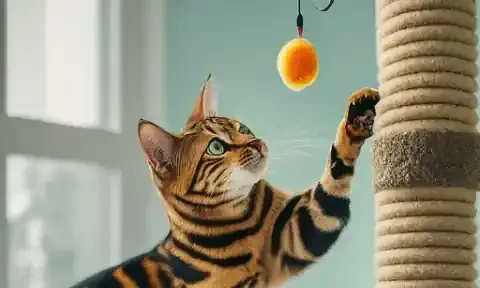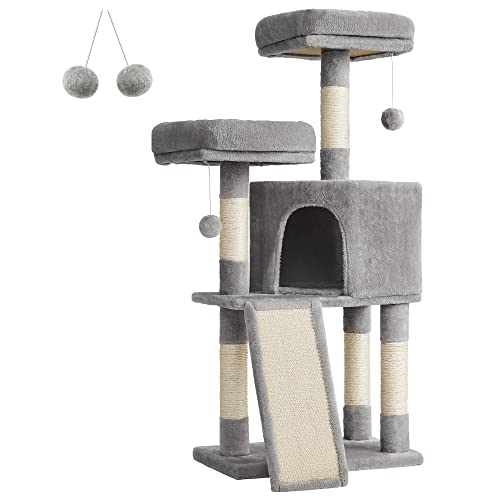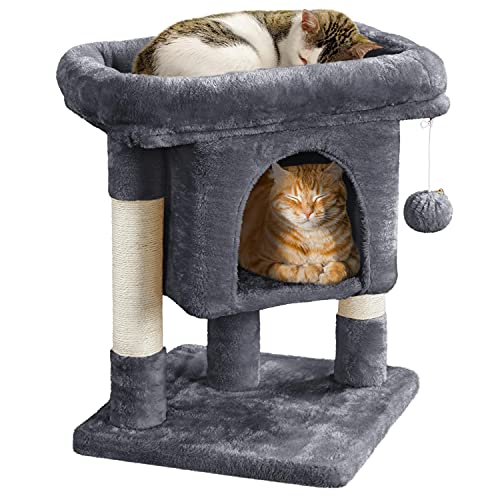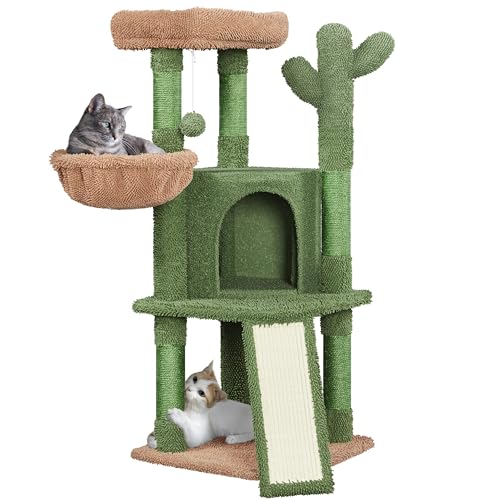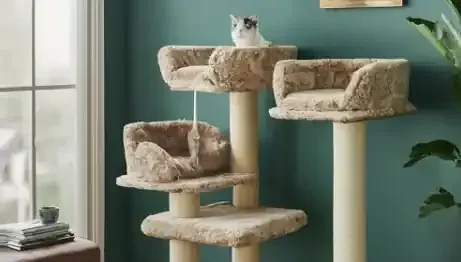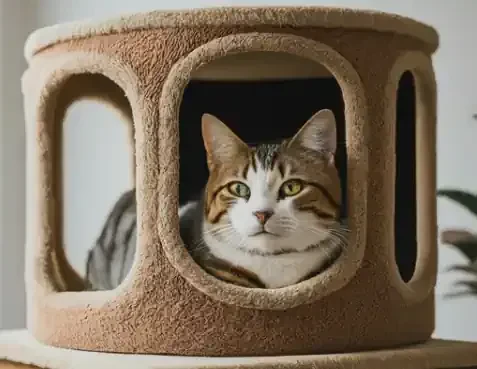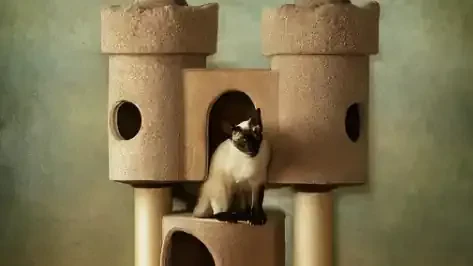Why Your Cat Needs a Cat Tree
Cats are natural climbers and explorers, with an innate desire to survey their surroundings from a high vantage point. A cat tree fulfills this instinctual need, offering them a dedicated space to climb, jump, scratch, and play. Beyond simply satisfying their natural instincts, cat trees provide a multitude of benefits for your feline friend's physical and mental well-being.
The Importance of Vertical Space for Cats
In the wild, cats seek out elevated spaces to escape predators, observe prey, and establish territory. Domestic cats retain these instincts, even within the safety of your home. Providing vertical space through a cat tree allows them to express their natural behaviors, reducing boredom and anxiety.
Benefits of Cat Trees for Feline Physical and Mental Health
Exercise: Climbing, jumping, and playing on a cat tree provides essential exercise, helping your cat maintain a healthy weight and muscle tone.
Scratching: A cat tree with sisal rope or other suitable scratching surfaces helps keep your cat's claws healthy and prevents them from damaging your furniture.
Mental Stimulation: The various levels, perches, and hiding spots on a cat tree provide mental stimulation, preventing boredom and behavioral problems.
Stress Relief: A designated space for climbing and exploring can help reduce stress and anxiety in cats, especially in multi-cat households.
Security: Elevated perches offer cats a sense of security and control, allowing them to observe their surroundings from a safe distance.
Types of Cat Trees: An Overview
Cat trees come in a vast array of styles, sizes, and configurations to suit different needs and preferences. Some popular types include:
Basic Cat Trees: Simple designs with a few platforms and scratching posts.
Tall Cat Trees: Ideal for cats who love to climb and survey their territory.
Cat Towers: Multi-level structures with perches, hammocks, and condos.
Wall-Mounted Cat Trees: Space-saving options for smaller homes or apartments.
Floor-to-Ceiling Cat Trees: These towering structures offer maximum climbing potential and a sense of adventure.
Cat Condos: Enclosed spaces that provide privacy and security for shy or timid cats.
Understanding the different types of cat trees available can help you narrow down your choices and select the best option for your feline friend.
Understanding Your Cat's Needs and Preferences
Choosing the purrfect cat tree isn't a one-size-fits-all endeavor. Your feline friend has unique preferences and requirements that should guide your decision. Taking the time to understand your cat's individual needs will ensure you select a tree that they'll genuinely love and use.
Age and Activity Level of Your Cat
Is your cat a spry kitten, a playful adult, or a distinguished senior? Their age and energy levels will significantly impact their preferences. Kittens might crave tall structures for climbing and exploring, while senior cats may prefer cat trees with easy-to-reach platforms and ramps to accommodate their joints. If you have an active cat, look for a cat tree with multiple levels, dangling toys, and interactive features. Less active cats may appreciate a simple design with cozy perches for napping.
Scratching Habits and Preferences
Does your cat prefer scratching vertical surfaces, horizontal surfaces, or both? Do they enjoy sisal rope, carpet, or corrugated cardboard? Observing their scratching habits will help you choose a cat tree with the right types of scratching surfaces. If your cat has a favorite scratching post, try to replicate the material and texture in the new cat tree.
Climbing and Jumping Abilities
How high can your cat comfortably jump? Are they confident climbers, or do they prefer more gradual inclines? Consider your cat's athleticism when selecting a cat tree. If they're not used to climbing, start with a shorter tree with easy-to-reach platforms. As they gain confidence, you can upgrade to a taller or more complex design.
Favorite Napping and Hiding Spots
Where does your cat like to nap or hide? Do they prefer enclosed spaces, open perches, or cozy hammocks? Understanding their preferred resting spots will help you choose a cat tree with the right combination of features. If your cat loves to burrow and hide, a cat tree with a condo or cave-like structure would be a great choice.
By carefully considering your cat's individual needs and preferences, you can ensure that you select a cat tree that not only provides them with a fun and enriching environment but also caters to their specific lifestyle and habits. Remember, a happy and engaged cat is a healthy cat, and the right cat tree can play a vital role in their overall well-being.
Essential Features to Look For In a Cat Tree
Beyond the aesthetics, a well-designed cat tree should incorporate specific features to cater to your cat's instincts and provide a fulfilling experience. These features not only promote play and exercise but also contribute to their overall health and well-being. Let's delve into the must-have elements that make a cat tree truly exceptional.
Height and Stability
A cat's natural inclination is to climb and survey their domain from an elevated position. Therefore, a cat tree should offer ample vertical space with multiple tiers or platforms. Ensure the structure is sturdy and stable to prevent wobbling or tipping, especially during enthusiastic play sessions. A wider base and high-quality materials contribute to overall stability.
Scratching Posts and Surfaces
Scratching is a vital behavior for cats, helping them shed old nail sheaths, mark territory, and stretch their muscles. A cat tree should incorporate various scratching surfaces, such as sisal rope, carpet, or corrugated cardboard. Vertical scratching posts allow for full-body stretches, while horizontal surfaces cater to different scratching preferences. Look for replaceable scratching posts to extend the life of the tree.
Perches, Platforms, and Hammocks
Cats love to perch and observe their surroundings, and a cat tree should provide a variety of resting spots to accommodate this behavior. Plush platforms, cushioned perches, and cozy hammocks offer different textures and levels for your cat to choose from. Some cats prefer open perches for a panoramic view, while others seek the security of enclosed spaces. Look for a cat tree with multiple perches at varying heights to keep your cat entertained and engaged.
Condos and Hiding Places
Cats are natural predators and prey, and having a place to hide helps them feel secure and less vulnerable. Enclosed condos or cubbyholes provide a safe haven for your cat to retreat and relax. These cozy hideaways can be especially appealing for shy or timid cats. Consider a cat tree with at least one enclosed space, preferably with multiple entry/exit points to prevent your cat from feeling trapped.
Additional Features (Toys, Sisal Rope, Etc.)
To further enhance your cat's enjoyment, look for cat trees with additional features like dangling toys, hanging mice, tunnels, or scratching posts wrapped in sisal rope. Interactive elements can encourage play and exercise, while dangling toys provide mental stimulation.
Remember, the best cat tree is one that caters to your cat's specific needs and preferences. Consider their age, activity level, scratching habits, and favorite napping spots when making your selection. By investing in a well-designed cat tree with the right features, you'll be providing your feline friend with a haven for play, relaxation, and overall well-being.
Choosing the Right Size and Style For Your Home
Selecting the perfect cat tree involves more than just considering your cat's preferences; it also requires a thoughtful assessment of your living space and overall aesthetic. Harmonizing your cat's needs with your home's layout and decor will create a seamless integration that benefits both you and your feline companion.
Available Space and Layout
Before diving into the vast world of cat trees, take a moment to evaluate the available space in your home. Measure the area where you envision placing the cat tree, considering both floor space and ceiling height. If you have limited space, a compact or wall-mounted cat tree might be a better option than a sprawling multi-level tower. Alternatively, if you have ample room, a taller tree with a wider base can provide a more extensive playground for your cat.
Consider the layout of your home as well. Do you have an open floor plan, or are there narrow hallways or corners? Choose a cat tree that complements the flow of your space without obstructing walkways or creating a cramped feel. If you have multiple rooms, you could consider placing smaller cat trees in different areas to provide variety for your cat.
Aesthetics and Matching Your Decor
While functionality is paramount, the aesthetic appeal of a cat tree should not be overlooked. Cat trees come in a wide range of styles, from minimalist and modern to rustic and traditional. Choose a design that complements your home's existing decor, creating a harmonious blend of form and function.
If you have a modern aesthetic, a sleek cat tree with clean lines and neutral colors might be a good fit. For a more traditional home, consider a cat tree with natural wood accents and plush fabrics. The color and material of the cat tree should also match the color scheme of your room.
Multi-Cat Households: Considerations
For households with multiple cats, choosing the right cat tree becomes even more crucial. Each cat needs their own space to climb, scratch, and rest without feeling crowded or territorial. Look for a cat tree with multiple levels, perches, and hiding spots to accommodate each cat's individual preferences. A larger tree with a sturdy base is essential to prevent it from tipping over during simultaneous play sessions.
Consider the different personalities and dynamics of your cats. If you have both shy and outgoing cats, provide a mix of open perches and enclosed condos to cater to their varying needs. You may even want to consider multiple cat trees placed strategically throughout your home to create separate territories for each cat.
By carefully considering the size, style, and layout of your home, you can find a cat tree that not only satisfies your cat's instincts but also enhances the overall aesthetic of your living space.
Materials: What To Look For (And What To Avoid)
The materials used in constructing a cat tree can significantly impact its durability, safety, and appeal to your feline friend. When choosing a cat tree, prioritize high-quality materials that are both safe and comfortable for your cat while being aesthetically pleasing and easy to maintain for you.
Sturdy Construction Materials (Wood, Metal)
The foundation of any good cat tree lies in its construction materials. Opt for solid wood or metal frames for maximum durability and stability. Avoid particleboard or pressboard, as these materials are prone to warping and breakage over time. Look for cat trees made from solid wood like pine or birch, or metal frames made from steel or aluminum. These materials can withstand daily wear and tear, ensuring your cat tree remains sturdy and safe for years to come.
Scratching Post Material (Sisal Rope, Carpet, Corrugated Cardboard)
Cats have diverse scratching preferences, so it's essential to choose a cat tree with various scratching surfaces. Sisal rope is a popular and durable option, offering a satisfying texture for scratching and stretching. Carpet can provide a softer surface for gentle scratching, while corrugated cardboard offers a different sensory experience. Ideally, look for a cat tree that incorporates a combination of these materials to cater to your cat's individual preferences.
Fabric and Upholstery Considerations
The fabric used for perches, platforms, and hammocks should be soft, comfortable, and easy to clean. Plush fabrics like faux fur or fleece can provide warmth and coziness for your cat. Consider choosing darker colors or patterns to camouflage shedding and dirt. Ensure the fabric is tightly woven and securely attached to the frame to prevent fraying or tearing.
Non-Toxic and Safe Materials
Your cat's safety is paramount, so choose a cat tree that's made with non-toxic materials and finishes. Avoid any cat trees that have been treated with harsh chemicals or contain small parts that could be ingested. Look for certifications from reputable organizations, such as the OEKO-TEX Standard 100, which ensures that the materials used in the cat tree are free from harmful substances.
By paying close attention to the materials used in a cat tree's construction, you can ensure that it is not only durable and aesthetically pleasing but also safe and comfortable for your feline companion. A well-made cat tree crafted from high-quality materials will provide years of enjoyment for both you and your cat.
Top Brands and Models: Recommendations For Different Needs
With the vast array of cat trees available, choosing the right one can feel like navigating a jungle. To help you make an informed decision, we've curated a list of top-rated brands and models that cater to different needs and preferences. Whether you have a playful kitten, a senior cat, or multiple feline companions, there's a perfect cat tree waiting to be discovered.
Best Cat Trees for Large Cats
Large cats need sturdy and spacious cat trees that can support their weight and provide ample room for stretching and climbing. Look for cat trees with wider bases, reinforced platforms, and strong scratching posts. Brands like Go Pet Club, Mau Lifestyle, and Vesper offer a range of cat trees designed specifically for larger breeds, with features like extra-large condos and sturdy sisal rope scratching posts.
Best Cat Trees for Small Spaces
If you live in an apartment or have limited space, a compact cat tree is a great option. Look for models with a smaller footprint that still offer plenty of vertical space for climbing and exploring. Brands like The Refined Feline, Frisco, and On2 Pets offer stylish and functional cat trees that fit seamlessly into smaller spaces.
Best Cat Trees for Kittens
Kittens are full of energy and curiosity, so they need a cat tree that can keep up with their playful nature. Look for cat trees with multiple levels, dangling toys, and interactive features like tunnels and hanging mice. Frisco, Furhaven, and Go Pet Club offer a variety of kitten-friendly cat trees that encourage exploration and play.
Best Cat Trees for Senior Cats
Senior cats may have decreased mobility and may prefer a cat tree with easy-to-access platforms and ramps. Look for models with lower perches, cushioned steps, and cozy nooks for napping. Brands like Kitty City, Armarkat, and AmazonBasics offer cat trees designed with senior cats in mind, prioritizing comfort and accessibility.
Best Budget-Friendly Cat Trees
You don't have to break the bank to provide your cat with a high-quality cat tree. Many affordable options offer excellent value for the price. Brands like FEANDREA, Yaheetech, and Go Pet Club have budget-friendly cat trees that don't compromise on quality or functionality. Consider your cat's individual needs and choose a cat tree that offers the best balance of features and affordability.
By exploring the recommendations for different needs, you can narrow down your choices and find a cat tree that perfectly suits your feline friend and your lifestyle. Remember, the ideal cat tree is one that your cat will love to use, providing them with hours of entertainment, exercise, and relaxation.
Cat Tree Safety: Important Considerations
Ensuring your cat's safety while enjoying their new cat tree is paramount. While these structures are designed for fun and enrichment, certain precautions must be taken to prevent accidents and injuries. By adhering to essential safety guidelines, you can create a secure environment for your feline friend to play and explore with confidence.
Secure Base and Anti-Tipping Features
A wobbly cat tree is a recipe for disaster. Look for a model with a wide, heavy base that provides stability and prevents tipping, even when your cat leaps or climbs with enthusiasm. Some cat trees come with additional anti-tipping features, such as wall anchors or weighted bases, which offer further protection against accidental toppling. If you have a particularly active or large cat, prioritize a cat tree with a broad base and reinforced construction.
Stable Perches and Platforms
Ensure that all perches and platforms are securely attached to the main structure. Check for loose screws, nails, or staples that could pose a hazard. Platforms should be spacious enough for your cat to comfortably lie down and turn around without feeling cramped or restricted. If the platforms seem flimsy or unstable, reinforce them with additional brackets or screws.
No Dangling Strings or Loose Parts
Cats are naturally curious and may try to chew or ingest dangling strings, loose threads, or small decorative items on the cat tree. These can pose a choking hazard or cause internal blockages. Regularly inspect the cat tree for any loose parts and remove them promptly. Choose cat trees with securely attached toys and avoid those with excessive decorations or dangling elements.
Non-Toxic Materials and Finishes
As mentioned earlier, the materials used in the cat tree should be non-toxic and safe for your cat. Avoid cat trees that have been treated with harsh chemicals or contain materials that could be harmful if ingested. Look for cat trees made from natural materials like sisal rope, untreated wood, and organic cotton. If you're unsure about the safety of a particular material, consult with your veterinarian or a reputable pet product retailer.
By prioritizing safety in your cat tree selection, you can create a worry-free environment for your feline friend to play, explore, and relax. Regular inspections and maintenance will ensure the cat tree remains a safe and enjoyable haven for your cat throughout its lifespan.
Where to Buy Your Cat Tree: Online Vs. In-Store
As you embark on your quest for the perfect cat tree, you'll face the decision of where to make your purchase. Both online and brick-and-mortar stores offer unique advantages and drawbacks, so weighing your options is crucial to ensure a smooth and satisfying shopping experience.
Benefits of Online Shopping (Variety, Price Comparison)
The digital realm of online shopping opens up a vast selection of cat trees from various brands and retailers. You can easily browse through countless models, compare prices, read reviews, and filter options based on your specific requirements. This convenience allows you to research thoroughly and find the ideal cat tree without leaving the comfort of your home.
Furthermore, online retailers often offer competitive prices and exclusive deals that may not be available in physical stores. You can also take advantage of user reviews and ratings to gauge the quality and popularity of different cat trees before making a purchase.
Benefits of In-Store Shopping (Seeing and Touching Products)
While online shopping offers convenience and variety, nothing beats the tactile experience of seeing and touching a cat tree in person. Visiting a brick-and-mortar store allows you to assess the quality of materials, test the sturdiness of the structure, and visualize how the cat tree would fit into your home.
In-store shopping also provides the opportunity to interact with knowledgeable staff who can offer personalized advice and recommendations based on your cat's specific needs and your budget. You can even bring your cat along to test out the cat tree and see if they show interest in it.
Reputable Retailers and Brands
Whether you choose to shop online or in-store, it's crucial to select reputable retailers and brands known for their quality and customer service. Some well-regarded online retailers for cat trees include Chewy, Amazon, and Wayfair. For in-store shopping, consider visiting pet stores like Petco or Petsmart, or specialty cat furniture stores if available in your area.
When selecting a brand, research their reputation for quality, durability, and customer satisfaction. Read online reviews, check for warranties or guarantees, and look for certifications that indicate the use of safe and non-toxic materials.
Ultimately, the best place to buy your cat tree depends on your personal preferences and priorities. If you value convenience, variety, and competitive prices, online shopping might be the ideal choice. However, if you prefer a hands-on experience and personalized advice, visiting a physical store could be more beneficial. Whichever route you choose, prioritize reputable retailers and brands to ensure you're investing in a high-quality cat tree that will bring joy and enrichment to your feline companion for years to come.
Making the Right Choice for Your Feline Friend
Selecting the perfect cat tree for your feline companion is a rewarding endeavor that can significantly enhance their quality of life. By carefully considering the factors discussed in this guide, you're well on your way to finding a cat tree that not only satisfies your cat's instincts but also complements your home and lifestyle.
Recap of Key Considerations
Remember, the ideal cat tree should:
Provide ample vertical space: Cater to your cat's natural climbing instincts with multiple levels and platforms.
Offer various scratching surfaces: Include sisal rope, carpet, or cardboard to cater to different scratching preferences.
Incorporate cozy resting spots: Provide perches, platforms, and hammocks at varying heights for napping and observing.
Include hiding spaces (optional): Offer a sense of security and privacy with enclosed condos or cubbyholes.
Be made with safe and sturdy materials: Prioritize high-quality construction and non-toxic materials for your cat's safety.
Fit your space and budget: Choose a cat tree that complements your home's layout and aesthetic while aligning with your budget.
Additional Tips for Encouraging Your Cat to Use the Tree
Place the cat tree in a strategic location: Choose a spot that's easily accessible and visible to your cat, preferably near a window or a favorite lounging area.
Introduce the cat tree gradually: Don't force your cat to use the tree. Allow them to explore it at their own pace, and reward them with treats or praise when they interact with it.
Sprinkle catnip on the tree: Catnip can entice even the most reluctant climbers to investigate and explore.
Play with your cat on the tree: Use toys or laser pointers to encourage your cat to climb and play on the tree.
Make the tree a comfortable space: Add a blanket or your cat's favorite toy to the top perch to make it more inviting.
Final Thoughts on Finding the Purrfect Cat Tree
Choosing a cat tree is an investment in your cat's happiness and well-being. By taking the time to research and select the right model, you're not only providing them with a fun and enriching environment but also strengthening your bond with your feline companion.
Remember, every cat is unique, and their preferences may evolve over time. Don't be afraid to experiment with different cat trees until you find the one that truly speaks to your cat's inner climber and explorer. The joy and satisfaction you'll witness as they conquer their new kingdom will make the search well worth it.
Should you have any further questions or need more assistance, please don't hesitate to reach out to us. Our team of cat enthusiasts is always happy to help you find the purrfect cat tree for your beloved furry friend.
Summary
Choosing the perfect cat tree is essential for your cat's well-being, offering them a dedicated space to climb, scratch, play, and relax. Understanding your cat's individual needs, such as their age, activity level, scratching habits, and preferred resting spots, is crucial for making an informed decision. When selecting a cat tree, prioritize essential features like height, stability, variety of scratching surfaces, perches, platforms, and enclosed hiding spaces. Consider the size and style of your home, as well as the specific needs of multi-cat households. Opt for sturdy construction materials and non-toxic finishes to ensure your cat's safety. Explore recommendations for top brands and models tailored to different needs, from large cats to kittens and seniors. By carefully evaluating all of these factors, you can create a safe and enjoyable environment for your feline friend to thrive.
